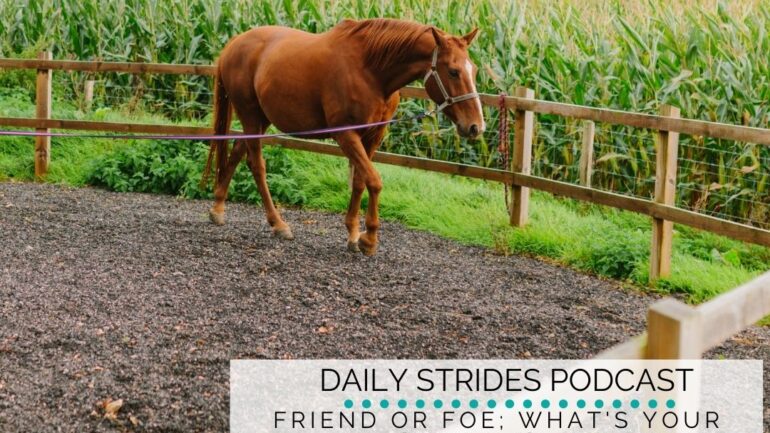Have you been using your lunging whip incorrectly? Have you decided not to use it at all?
Your lunging whip is one of the best aids you have to help you clarify your communication when it comes to lunging your horse. However, in order for it to be of benefit, it must be used correctly.
And, unfortunately, the lunging whip can often be misused, and often, therefore, misunderstood when it comes to aids in lunging and riding.
Lunging Whip; What’s in a Name?
For many riders, their resistance to and incorrect use of the lunging whip is caused by the name we have given this piece of equipment. I have a feeling that if a lunging whip was called a pointer or a demonstrator, it would ‘feel’ different for many riders to incorporate it into their conversation with their horse.
The lunging whip is a really useful artificial aid. It just has an unfortunate name!
A lunging whip is an inanimate object. It can not do anything itself. It needs someone to be intentional with it in order for it to actually ‘do’ anything. If you feel uncomfortable about using a lunging whip with your horse, this is because of a thought you are thinking. My advice is to identify this thought – and then actively think of a better one!
You can shape how this artificial aid adds to your conversation with your horse by how intentional you are when using it.
Re-schooling the Rider
The second big challenge many riders have with the lunge whip is how they are actually using it. Carrying it too high. Swinging it around. Directing air traffic. Not carrying it at all… These are all ways that we can use this aid without actually ‘using’ the aid in the way it can best communicate with our horse.
Your lunging whip should be ‘carried’ just like you carry your hands when you hold the reins. The end of the whip pointing towards the horse should be kept down.
In fact, if you stick to the rule that the end of the whip is kept hock height or lower, it will help you have a better and more consistent conversation with your horse. The end of the whip, in this case, is where the hard part of the whip joins the sash.
Engaged Versus Neutral
I like to think of your lunging whip when lunging as having a similar role to your legs when you ride. And, just like your legs, you never want to actually have it ‘off’ the horse. In riding, we don’t want daylight between your legs and your horse’s sides.
In lunging, we don’t want your whip so open that it is no longer part of the conversation.
Imagine that the track your horse works on while lunging is a pizza. You, your horse, and your aids create the pizza slice. Your horse is the edge of the slice. Your lunge line is one side. Your lunging whip is the other side. And you are the narrow bit at the center of the pizza.
If your ‘pizza slice’ is taking up more than a quarter of your pizza, your lunging whip is too ‘open’!
Re-schooling Your Horse
Many rider’s greatest challenges with a ‘Long Tom’ (another name for this aid) come from the fact that their horse has unhappy associations with the whip. In this case, it is the job of the rider (lunger) to desensitize and re-school the horse to the lunging whip.
How your horse reacts to a lunging whip is also just a thought. You can help him to reshape his thoughts on this through retraining and re-schooling.
It’s a little like a hot or sensitive horse. Riding them without any leg is not the way to work through that. Rather allowing the horse to become comfortable with the leg and using the leg as aid will help both horse and rider going forward.
Helping your horse to understand and become comfortable with your lunge whip can only help. You can then use this artificial aid to clarify your natural aids and have better conversations on the lunge.
Developing Your Aids
Once you have done the work with yourself and your horse, your lunge whip can really help you to begin developing your overall conversation on the lunge. How you use it can be subtle and also more obvious, depending on you and your horse’s level of training.
It is important to keep in mind that your artificial aids help either backup or clarify your natural aids. Your lunging line is no different.
Used alone and by itself, it will be overbearing and work against the overall development of the relationship. However, when used with your other aids, as a blend, it has the potential to really move things forward.
Happy Lunging
Lorna
Additional Bits and Bobs to Help You:-
-
-
- “3 Days to Successful Lunging” Guided Audio Training
- Improving Your Riding Coordination & Aids While Lunging
- Loose Lunging Versus Lunging
- Lunging for Riding – 4-week step by step program to transform your lunging experience
- Online community for equestrians working on their mindset & fitness
- Online Community for equestrians focusing on re-schooling horses (and ex-racehorses)
- The Daily Strides Podcast on iTunes
- The Daily Strides Podcast on Stitcher Radio
-

